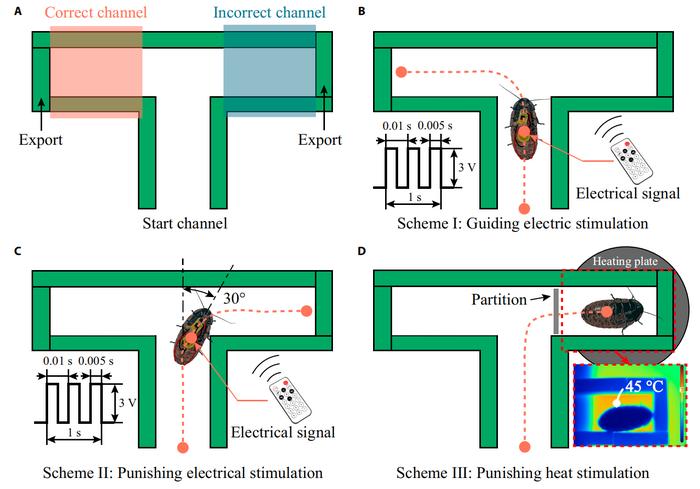A team of researchers from the Beijing Institute of Technology has embarked on an innovative exploration of insect behavior, focusing specifically on the operant learning capabilities of cockroaches in a controlled environment. Their groundbreaking study introduces a steering control mechanism that harnesses electrical stimulation to guide the movement of Madagascar cockroaches within a specially designed T-maze. This novel approach seeks to enhance our understanding of how electrical signals can influence memory formation and behavioral conditioning in insects, a field that remains ripe for exploration and advancement.
In a notable shift from traditional training methodologies, the researchers designed experiments that capitalized on the cockroaches’ innate responses to sensory stimulation. By applying electric signals to the cerci—sensory organs crucial for balance and spatial awareness—scientists were able to induce specific turning behaviors in the insects. This technique allows for a more gentle and effective means of training compared to the conventional punitive methods that often rely on negative reinforcement, such as electric shocks or thermal punishment.
The study yielded compelling results, with cockroaches demonstrating marked preferences for certain maze channels after only five consecutive sessions of training that focused on electrical stimulation. The researchers observed that the cockroaches achieved a remarkable memory score of 83.5%, significantly outpacing the outcomes related to other traditional training strategies. The success of this ergonomic training method suggests a potential paradigm shift in how we train not only insects but possibly other organisms in the future.
Importantly, the successful application of electrical stimulation to enhance memory formation in cockroaches opens a plethora of opportunities for the further development of cyborg insects. These cyborgs, capable of executing complex tasks through stimulation, have already proven useful in detection and reconnaissance scenarios. As concerns about ecological sustainability and efficient resource management grow, the use of bio-engineered insects may play a vital role in various applications, ranging from environmental monitoring to pest control.
The researchers meticulously developed their experimental methodology, which consisted of several phases. They began by selecting adult Madagascar cockroaches—known for their robust size and adaptability—as experimental subjects. A T-shaped training maze was constructed, featuring both thermal and electrical punishment mechanisms, to create a controlled environment for the study. Furthermore, a wireless micro-stimulator was integrated to accurately apply the electric impulses needed to guide the cockroaches’ movements effectively.
An essential part of the research involved determining optimal electrical stimulation parameters so that behavior could be controlled precisely during training. By stimulating the turning response of the unilateral caudal cord, researchers could induce the desired turns without causing undue stress to the insects. This innovative approach marks a significant departure from previous punitive methodologies that were often detrimental to the subjects’ well-being and could lead to adverse reactions.
This study compared three training strategies, including thermal stimulation, guided electrical stimulation, and punitive electrical stimulation. Researchers rigorously collected data on the memory performance of the cockroaches subjected to each of these modalities. The results showed that those trained with guided electrical stimulation performed significantly better than their counterparts, achieving an impressive memory retention score that highlighted its efficacy in promoting learning.
The findings reveal not only the potential for improved learning techniques in insects but also raise intriguing questions about memory mechanisms across different species. The results also emphasize the importance of humane treatment in the development of training methodologies. Future research endeavors may expand on this work, integrating sensory cues such as visual or olfactory stimuli to enhance recognition and retention further, thus paving the way for more sophisticated cyborg insect applications.
In addition to practical applications, the scientific implications of this research are profound. Understanding the intersection of electrical stimulation and memory formation could provide insights into broader neurological processes across species. It may help elucidate how sensory organs contribute to learning and memory, offering potential advancements in both biological research and artificial intelligence models derived from natural systems.
The research described in this groundbreaking paper, “Cercus Electric Stimulation Enables Cockroach with Trajectory Control and Spatial Cognition Training,” is likely to inspire further studies aimed at exploring the cognitive capacities of not just cockroaches but various insects and possibly other organisms as well. It signals a growing interest in the cognitive abilities of insects, which have been underestimated compared to mammals in terms of learning and memory.
As the scope of bioengineering expands, the fusion of biological creatures with artificial systems such as sensors and stimulators may lead to unprecedented innovations in environmental science, agriculture, and even healthcare. The potential applications are vast, as cyborg insects could be deployed for maintenance of ecological balance, monitoring environmental changes, and even participating in search and rescue missions.
Despite the promising results, ethical considerations surrounding the manipulation of living organisms continue to emerge. As we navigate the future of bioengineering and cyborg development, it will be crucial to ensure that such advancements are pursued responsibly, with thoughtful consideration of the welfare and rights of all life forms involved.
Awareness and education on the subject of cyborg insects and their capabilities will be vital as we move further into a future where technology and biology coalesce in unprecedented ways. This research underscores not only scientific achievement but also sets a framework for responsible innovation in biological applications and the complex interplay between technology and ecology.
In summary, the research provides a foundation not only for future experiments into the behavior and training of cyborg insects but also for an ongoing conversation about ethics in biological engineering. It propels us into an era in which guiding electrical stimulation may become commonplace in various fields, showcasing how we can learn effectively from the natural world and apply that knowledge toward innovative solutions.
Subject of Research: Operant learning training of cockroaches using electrical stimulation.
Article Title: Cercus Electric Stimulation Enables Cockroach with Trajectory Control and Spatial Cognition Training
News Publication Date: March 7, 2025
Web References: Cyborg and Bionic Systems
References: DOI: 10.34133/cbsystems.0154
Image Credits: Li Yu, Beijing Institute of Technology
Keywords
Insects, Memory formation, Electrical stimulation, Operant conditioning, Cyborg technology, Behavioral research.




